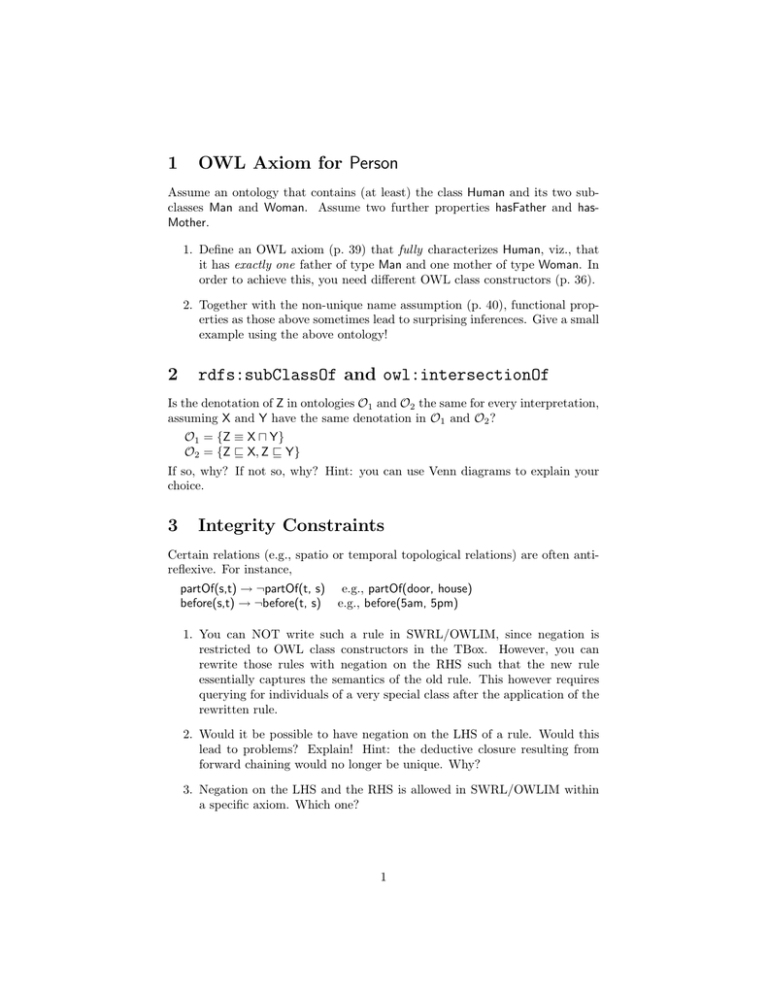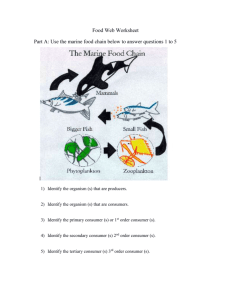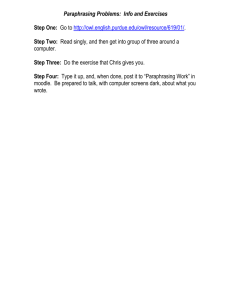1 OWL Axiom for Person
advertisement

1
OWL Axiom for Person
Assume an ontology that contains (at least) the class Human and its two subclasses Man and Woman. Assume two further properties hasFather and hasMother.
1. Define an OWL axiom (p. 39) that fully characterizes Human, viz., that
it has exactly one father of type Man and one mother of type Woman. In
order to achieve this, you need different OWL class constructors (p. 36).
2. Together with the non-unique name assumption (p. 40), functional properties as those above sometimes lead to surprising inferences. Give a small
example using the above ontology!
2
rdfs:subClassOf and owl:intersectionOf
Is the denotation of Z in ontologies O1 and O2 the same for every interpretation,
assuming X and Y have the same denotation in O1 and O2 ?
O1 = {Z ≡ X u Y}
O2 = {Z v X, Z v Y}
If so, why? If not so, why? Hint: you can use Venn diagrams to explain your
choice.
3
Integrity Constraints
Certain relations (e.g., spatio or temporal topological relations) are often antireflexive. For instance,
partOf(s,t) → ¬partOf(t, s) e.g., partOf(door, house)
before(s,t) → ¬before(t, s) e.g., before(5am, 5pm)
1. You can NOT write such a rule in SWRL/OWLIM, since negation is
restricted to OWL class constructors in the TBox. However, you can
rewrite those rules with negation on the RHS such that the new rule
essentially captures the semantics of the old rule. This however requires
querying for individuals of a very special class after the application of the
rewritten rule.
2. Would it be possible to have negation on the LHS of a rule. Would this
lead to problems? Explain! Hint: the deductive closure resulting from
forward chaining would no longer be unique. Why?
3. Negation on the LHS and the RHS is allowed in SWRL/OWLIM within
a specific axiom. Which one?
1
4
Forward Chaining
Why does the forward chaining algorithm (p. 52) terminate, assuming we are
dealing with safe entailment rules (p. 48) ?
5
Reducibility to Consistency
On page 41, we said that the basic inference problems are all reducible to
(in)consistency. Reformulate subsumption: C vO D. You might again use
Venn diagrams to explain your reformulation.
6
Entailment Rules
Page 56 has presented four OWL entailment rules in OWLIM notation. Now,
properties in OWL can either be (see pp. 34, 36, 37)
• datatype properties of rdf:type owl:DatatypeProperty
example: hasAge(peter, 42)) or
• object properties of rdf:type owl:ObjectProperty
example: marriedWith(peter, mary)).
Orthogonal to this, properties in OWL are furthermore classified as being transitive, symmetric, functional , etc. (p. 35). Write OWL entailment rules that
address functional object as well as functional datatype properties (you will
probably need inequality constraints over variables; see p. 57). Are these rules
different. Why?
2

